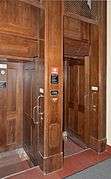Paternoster



A paternoster (/ˈpeɪtərˈnɒstər/, /ˈpɑː-/, or /ˈpæ-/) or paternoster lift is a passenger elevator which consists of a chain of open compartments (each usually designed for two persons) that move slowly in a loop up and down inside a building without stopping. Passengers can step on or off at any floor they like. The same technique is also used for filing cabinets to store large amounts of (paper) documents or for small spare parts.[1] The much smaller belt manlift which consists of an endless belt with steps and rungs but no compartments is also sometimes called a paternoster.
The construction of new paternosters was stopped in the mid-1970s due to safety concerns, but public sentiment has kept many of the remaining examples open.[2] By far most remaining paternosters are in Europe, with perhaps 230 examples in Germany, and 68 in the Czech Republic. Only two have been identified by hobbyists outside Europe: one in Malaysia, another in Peru.[3][4]
History
Peter Ellis installed the first elevators that could be described as paternoster lifts in Oriel Chambers of Liverpool in 1868.[5] In 1877, British engineer Peter Hart obtained a patent on the first paternoster.[6] In 1884, the Dartford, England, engineering firm of J & E Hall built its "Cyclic Elevator".
The name paternoster ("Our Father", the first two words of the Lord's Prayer in Latin), was originally applied to the device because the elevator is in the form of a loop and is thus similar to rosary beads used as an aid in reciting prayers.[7]
Paternosters were popular throughout the first half of the 20th century because they could carry more passengers than ordinary elevators. They were more common in continental Europe, especially in public buildings, than in the United Kingdom. They are rather slow elevators, typically traveling at about 0.3 metres per second (0.98 ft/s), to facilitate getting on and off successfully.[8]
A paternoster was used in the Dalek headquarters in the 1965 film Dr Who and The Daleks.
Safety
The construction of new paternosters is no longer allowed in many countries because of the high risk of accidents (people tripping or falling over when trying to enter or exit). In 2012, an 81-year-old man was killed when he fell into the shaft of a paternoster in The Hague in The Netherlands.[9] Elderly people, disabled people, and children are the most in danger of being crushed or losing a limb.[10]
In 1989, the paternoster in Newcastle University's Claremont Tower was taken out of service after a passenger, attempting to ride the lift as it transitioned from upward to downward travel, became caught in the drive chain. This required a rescue by the local fire service. A conventional lift was subsequently installed in its place.
In West Germany, new paternoster installations were banned in 1974, and there was an attempt to shut down all existing installations in 1994.[6] However, there was a wave of popular resistance to the ban at that time, and to another prospective ban in 2015.[6][11] As of 2015, Germany has 231 paternosters.[6]
In April 2006, Hitachi announced plans for a modern paternoster-style elevator with computer-controlled cars and standard elevator doors to alleviate safety concerns.[12][13] A prototype was revealed as of February 2013.[14]
Surviving examples
As a result of safety issues, many paternoster lifts have been shut down, but a few survive around the world.[15] In Kiel, the State Parliament building for the German state of Schleswig-Holstein has had a working paternoster since 1950.[16] In Berlin, the offices of the conservative tabloid Bild use a 19-storey paternoster, whose continued operation was vigorously defended editorially by the newspaper.[6] The Arts Tower at the University of Sheffield[17] has a paternoster said to be the largest in the world.[18] In the late 1990s a paternoster was still in use in a building on King Street, Manchester occupied by branch of the Natwest bank.
Gallery
- View of a working paternoster
- View from inside a working paternoster
 Paternoster in Vienna, built c.1910
Paternoster in Vienna, built c.1910 Vienna Town Hall, built c.1918
Vienna Town Hall, built c.1918- Modern paternoster in Berlin
- Paternoster in use at German publisher
.jpg) Paternoster in Parliament House, Helsinki
Paternoster in Parliament House, Helsinki View from inside a paternoster, showing floor slab
View from inside a paternoster, showing floor slab- View from working paternoster in the Albert Sloman Library, University of Essex, prior to 2014
 Paternoster machinery in Prague
Paternoster machinery in Prague Ground floor lobby offering a choice of paternoster or lift
Ground floor lobby offering a choice of paternoster or lift In this Hamburg shopping mall, artwork has replaced the old paternoster
In this Hamburg shopping mall, artwork has replaced the old paternoster
See also
References
- ↑ "Paternosterkast". Bertello. Archived from the original on 7 May 2009. Retrieved 11 December 2010.
- ↑ Bertrand Benoit (25 June 2015). "Is It Time for Germany’s Doorless Elevators to Move On?". WSJ.
- ↑ Michele Lent Hirsch. "Ride This Bizarre, Old-School Elevator Before They All Shut Down". Smithsonian.
- ↑ "PatList". flemming-hamburg.de.
- ↑ "In the Footsteps of Peter Ellis". 15 October 2016.
- 1 2 3 4 5 Benoit, Bertrand (25 June 2015). "Is It Time for Germany’s Doorless Elevators to Move On?". Wall Street Journal. Retrieved 26 June 2015.
- ↑ "Paternoster, n.". Oxford University Press. dictionary.oed.com. 8 March 2010.
- ↑ Strakosch, George R. (1998). The vertical transportation handbook. Wiley. pp. 99–100. ISBN 978-0-471-16291-9. Retrieved 22 July 2010.
- ↑ "Dodelijk ongeluk liftschacht was op reünie" (in Dutch). ANP. 14 April 2012.
- ↑ "This elevator can be hazardous to your health". The Associated Press, in The Times-News. 9 July 1993. Retrieved 22 July 2010.
- ↑ Kate Connolly (14 August 2015). "Lovin' their elevator: why Germans are loopy about their revolving lifts". The Guardian. Retrieved 14 August 2015.
- ↑ Staedter, Tracy (June 2006). "Lifts in Loops". Fast Company (106). p. 35. Retrieved 11 November 2016.
- ↑ "Development of basic drive technology improve innovative transportation capacity of the elevator "circulating multi-car elevator"". News Release (in Japanese). Hitachi. 1 March 2006. Retrieved 12 July 2010.Google translation
- ↑ "Circulating Multi-Car Elevator System "Exponential increase in carrying capacity"". Hitachi. 25 June 2013.
- ↑ Flemming, Wolfgang. "Liste laufender Paternoster (List of ongoing paternosters)" (in German). Retrieved 26 June 2015.
- ↑ "Landtag SH - State Parliament of Schleswig-Holstein". www.landtag.ltsh.de. Retrieved 2016-01-20.
- ↑ "The largest Paternoster elevator in the world - Doobybrain.com". Doobybrain.com.
- ↑ University of Sheffield. "Campus landmarks". sheffield.ac.uk.
External links
| Wikimedia Commons has media related to Paternoster. |
- The Elevator Museum
- List and photos of paternoster lifts (in German)
- Paternosters still in operation in Germany, Switzerland, and Austria (in German)
- Link to a tour of the University of Essex Albert Sloman library in England with picture of the paternoster lift
- Pages about history of paternosters in the world and especially in the Czech Republic (in Czech) — List of all paternosters in Prague with information and photographs; technical directives of the European Union for paternosters
- History and photos of the I.G. Farben Building (now the Poelzig-Bau) in Frankfurt/M, Germany, famous for its paternosters
- Information and photos regarding the GEC Marconi paternoster featured in "The Prisoner" TV series
- Paternoster at the NIG ("Neues Institutsgebäude") - University of Vienna. In operation until 2007 Videodocumentation from 1996